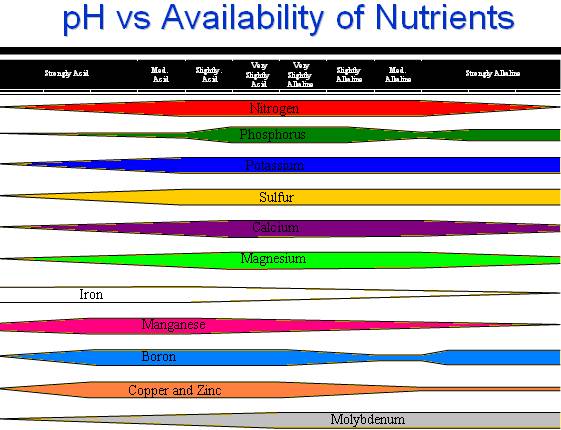KNOW THE RESPONSE OF CORN, ALFALFA, PERENNIAL GRASSES, WHEAT, OATS, AND SOYBEANS TO A. SOIL PH RANGE, B. SOIL DRAINAGE CLASSIFICATION RANGE
A) Soil pH range

Availability of essential minerals (click to enlarge) |
Soil pH affects nitrogen fixation as nodulation is inhibited when soil pH is low. Element availability is also affected. At low pH Aluminum and Manganese are toxic and Calcium, Magnesium and Molybdenum are deficient . |

Alfalfa yield
(click to enlarge) |
Soil pH also has an effect on species selection. Most crops grow best between 6.0 and 7.0 pH because of maximum nutrient availability. Acid-tolerant rye and oats can grow well at a pH of 5.5- 6.0. Acid-sensitive crops such as barley, wheat, soybeans, and corn require a soil pH of above 6.2 for maximum yield. Some soils in NY have a pH of close to 8.0 but corn, soybeans, and wheat are adapted to these alkali soils because of low sodium content in Northeast soils. An example of yield response of alfalfa and red clover to soil pH can be seen in the adjacent figure. In general, clovers can tolerate lower soil pH than alfalfa. |
B) Soil drainage classification range
The relative ability of a soil to permit drainage of excess water from the entire soil profile is known as soil drainage. soils are classified into drainage groups by their moisture status during the growing season. The classes are as follows: excessively drained, well-drained, moderately well drained, somewhat poorly drained, poorly drained and very poorly drained.
 |
Soil drainage affects species selection as many species are greatly impacted by soil drainage in the Northeast. Poorly-drained soils retard the growth and development of Northeast grain crops when flooding occurs early in the season. Corn is most sensitive to flooding early in the season at the V1-V5 stage. Corn will drown out when subjected to an extended period of ponded water in May until mid-June, when the growing point typically is now above the ground. Corn and wheat are very sensitive to poor-drainage before the growing point is above the ground. |
Corn and wheat are very sensitive to poor-drainage before the growing point is above the ground. Wheat can also drown out or heave out of the ground in the early spring on these poorly drained soils when they go through a freezing and thawing cycle. Corn and wheat continue to be sensitive later in the season and will show yellowing, reduced growth, and delayed development through their vegetative growth. Once both crops are flowering, they can tolerate standing water in the field.

Orchardgrass tolerance
(click to enlarge) |
Soybeans are also sensitive early in the season and can drown out but they are not as sensitive as corn. Soybeans continue to be sensitive to poorly drained soils during the flowering period because nitrogen fixation is sensitive to flooding. Small grains tolerance to poor drainage decreases as follows: rye > oats >wheat > barley. Reed canarygrass is most tolerant to wet soils (droughty soils as well) with tall fescue > smooth bromegrass > orchardgrass > timothy> alfalfa becoming successively less tolerant. Alfalfa and most cool-season grasses cannot survive poor drainage conditions affecting their long term persistence as a perennial in the field. |
Water requirements during growth and development vary by species. Cool-season grasses have approximately twice the water requirement of warm-season grasses (e.g. switchgrass). Water is critical in the early establishment phase. Water needs for established forages cycle with the harvest regime and are NOT critical at reproductive stages.
Water requirements for forage crops are NOT critical at reproductive stages. Forage yield is affected by soil type, native drainage class, and by artificial drainage.




